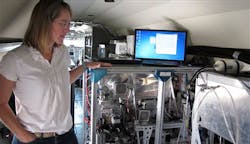Researchers Study How Wildfires Change Atmosphere
Aug. 16--PASCO, Wash. -- A Gulfstream-1 plane at Pasco's Tri-Cities Airport may help researchers better understand the mystery of how particles from wildfires change the atmosphere.
So far this summer, the plane has flown 11 times over wildfires in the Pacific Northwest, sucking in air to feed a dazzling array of equipment. Most recently, researchers flew 3,000 feet over a fire that covered more than 100,000 acres near Boise.
The data collected on the particles -- too small to see with the naked eye -- will help researchers understand the effect aerosols have on climate change and what the Earth's climate may look like in 50 to 100 years.
And that's information that can be used to help make policy decisions, said Larry Kleinman, one of the lead investigators for the Biomass Burning Observation Project.
The U.S. Department of Energy's Atmospheric Radiation Measurement (ARM) Program is paying for the study, which involves scientists from the Brookhaven National Laboratory in New York, the Pacific Northwest National Laboratory in Richland and other institutions.
Their focus are aerosols -- the particles given off during a fire that can have either warming or cooling effects.
When a fire is burning, it releases aerosols, sootlike particles that absorb sunlight and release heat, Kleinman said.
When a fire is just smoldering, organic materials form around the soot-like particle, reflecting sunlight and causing cooling, he said.
The stage of the fire and the fuels, such as grass, shrubs and trees, cause different aerosols and affect the properties of clouds, Kleinman said. The number and types of particles also result in different clouds, triggering warming or cooling.
"All fires are not the same," explained Kleinman, who works at Brookhaven National Laboratory along with the other lead investigator, Arthur Sedlacek.
Since the flights started in July, most of the samples have been collected when fires were smoldering, so Kleinman said they have observed a net cooling effect. Some of the instruments being used are one of a kind, Kleinman said.
One device is able to measure the chemical composition of the organic material that has condensed onto soot particles.
Outside the plane, a metal tube that looks like a bent straw sucks in air for a mammoth instrument -- an aerosol mass spectrometer. The equipment was modified to measure soot particles to help determine the amount of organic material in the soot, Kleinman said.
Also inside the cramped plane, another instrument dries air and puts it through different humidity levels to see how clouds will form, said Jennifer Comstock, deputy director of the ARM aerial facility.
The scientists still will be collecting data in the Pacific Northwest through early September, then move Oct. 1 to Memphis, Tenn.
Copyright 2013 - Tri-City Herald (Kennewick, Wash.)
